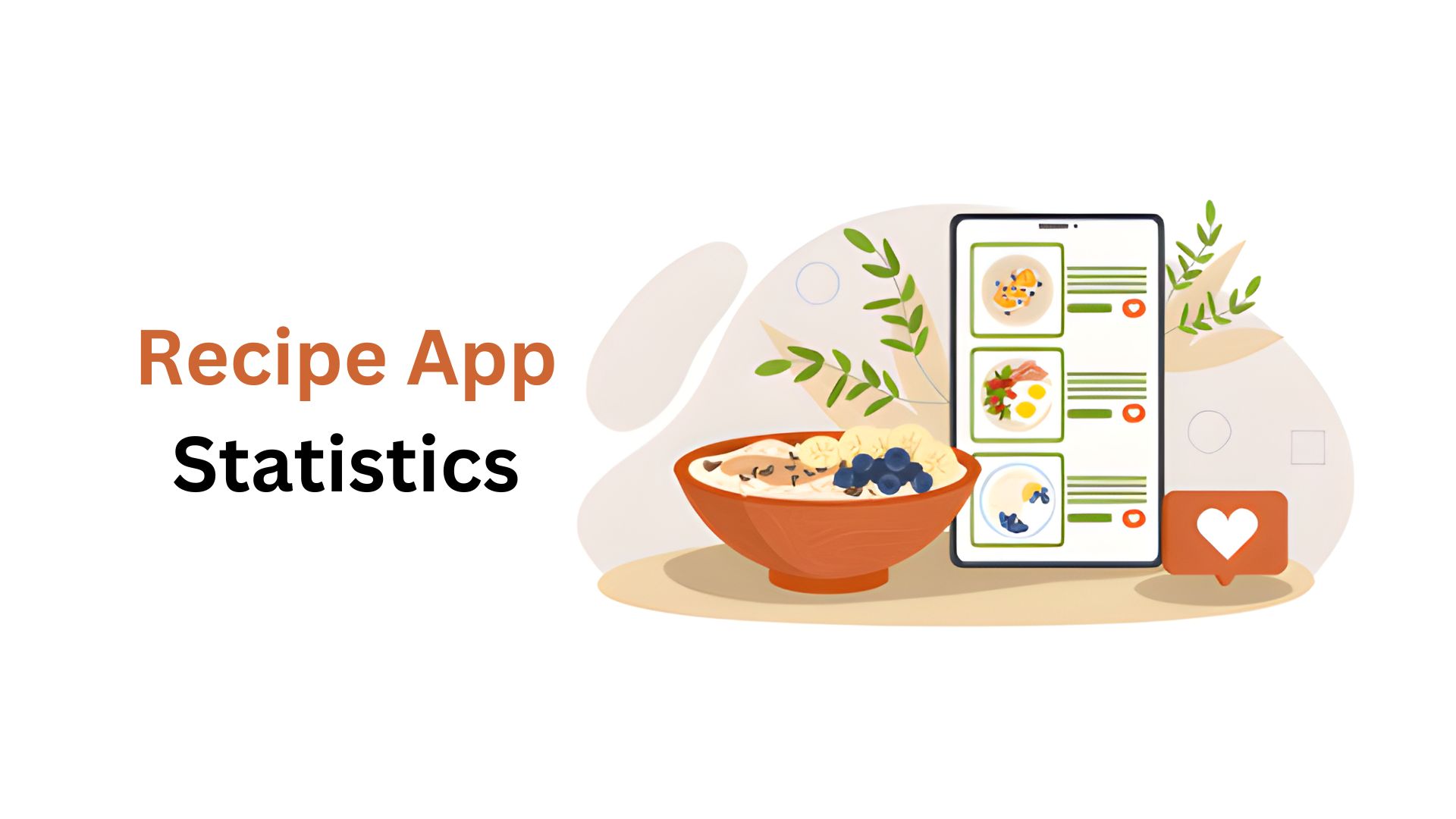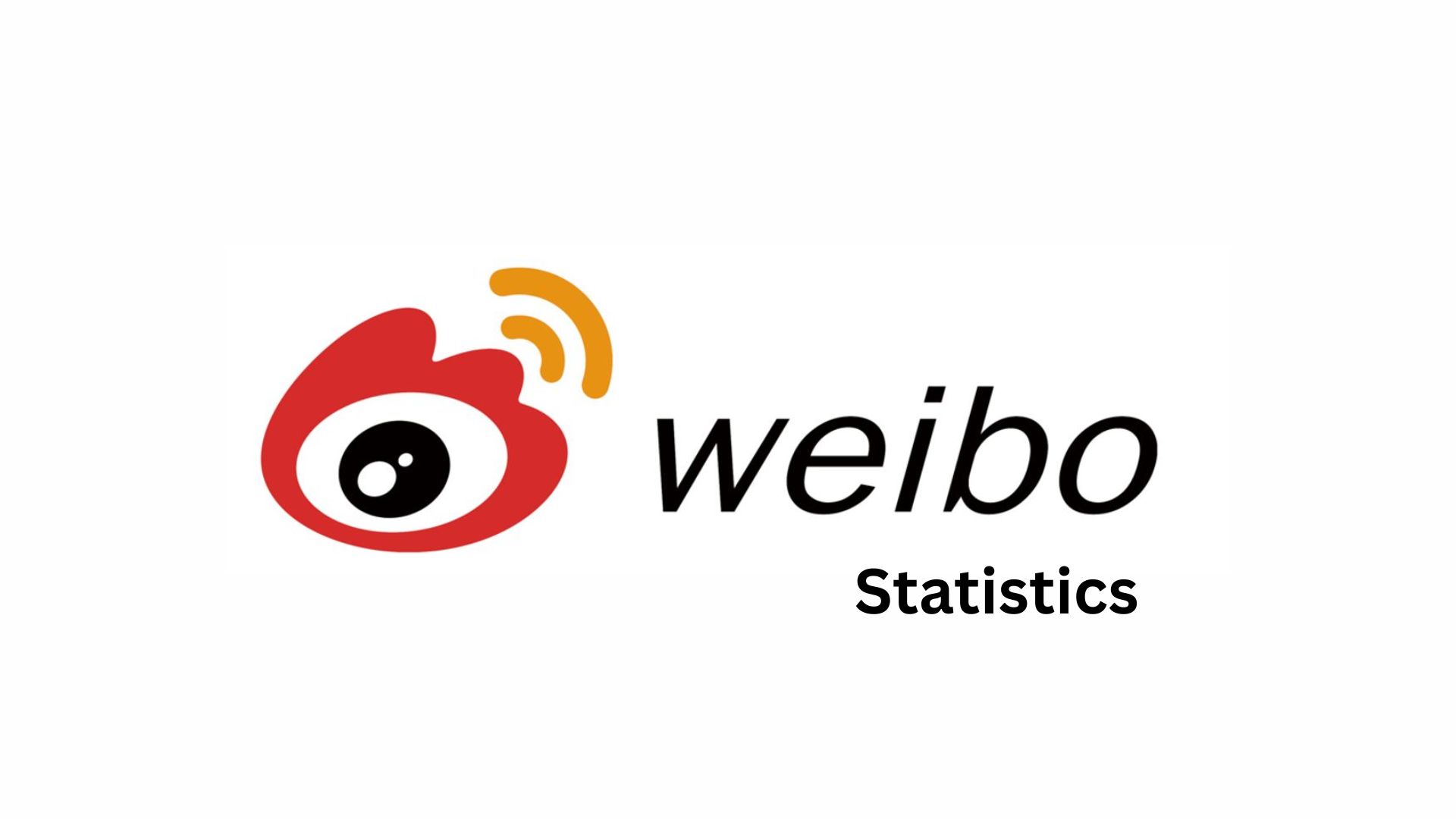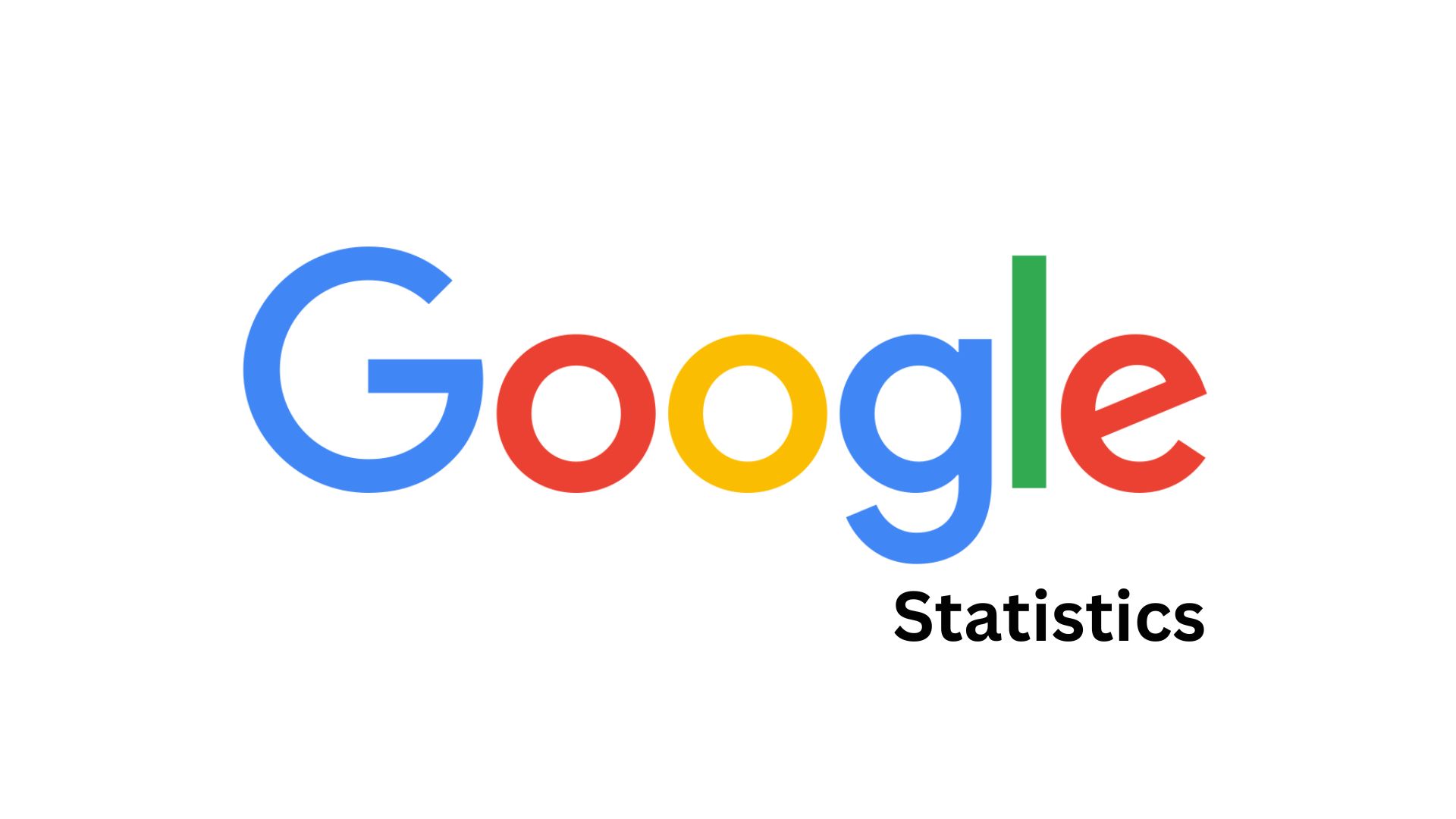Creator Economy Statistics By Market Size, Startups, Revenue and Facts (2025)
Updated · Sep 12, 2025
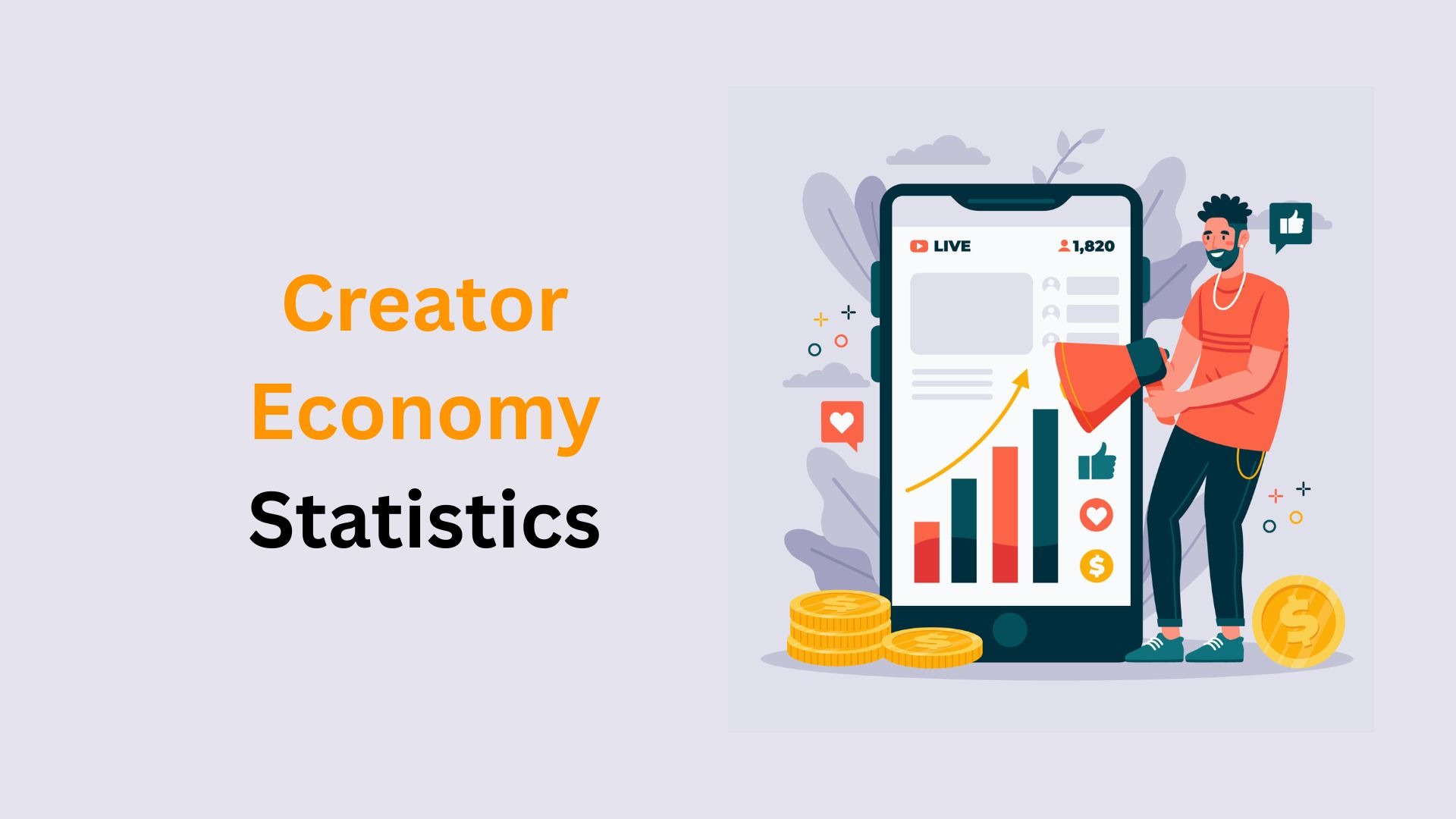
Table of Contents
- Introduction
- Editor’s Choice
- Creator Economy Market Statistics
- Creator Economy Startups Statistics
- By Platform
- By Content Types
- By Demographics
- By Monetization Methods
- By Content Creators
- By Region
- Countries With the Most Creators Statistics
- Content Creator Top Revenue Sources Statistics
- Company Supporting Creator Economy by Revenue
- Ways Brands Can Leverage the Booming Creator Economy
- Creator’s Earning Statistics
- Creator Economy Engagement Statistics
- Conclusion
Introduction
Creator Economy Statistics: The creator economy, sometimes called creator marketing or the influencer economy, is a system powered by software that supports independent creators. These creators make and share content, products, or services directly with their audiences using social media and AI tools.
People like YouTubers, influencers, podcasters, and digital artists earn money through ads, sponsorships, subscriptions, and selling merchandise. By 2025, millions of people around the world are expected to turn their creativity into a steady source of income.
Editor’s Choice
- According to the market.us report analysis, by 2025, the global market of the Creator Economy will secure around USD 181.8 billion in revenue.
- The North American region holds 37.4% of the market, resulting in USD 55.8 billion in revenue.
- Creator Economy Statistics shows that in 2024, the U.S. creator economy is valued at USD 50.9 billion with a 19.3% CAGR.
- In contrast, the United States accounted for 91.2% of the creator economy market share, while Canada made up the remaining 8.8%.
- In the same period, social media platforms lead with a 27.8% share, while video streaming platforms follow at 24.5%.
- In content formats, video dominates with 23.8%, while music accounts for 18.3%, supported by short-form audio.
- Meanwhile, brand collaborations are the main monetization method at 23.5%, slightly ahead of advertising revenue at 20.9%.
- Amateur creators form 64.1% of the market, with professionals at 35.9%.
- market.biz further states that the creator economy has grown rapidly, with over 207 million content creators worldwide.
- In the United States alone, 162 million people identify as creators, and more than 45 million work professionally.
- Around 46.7% of them are full-time, while 70% spend 10 hours or fewer each week producing content.
- On average, it takes about 6.5 months for a creator to earn their first dollar.
- Only 10% of influencers make USD 100,000 or more annually.
Creator Economy Market Statistics
- The Global Creator Economy Market is expected to reach USD 1,072.8 billion by 2034, up from USD 149.4 billion in 2024, with a CAGR of 21.8% during the forecast period from 2025 to 2034.

- In 2024, North America held a dominant market position, accounting for 37.4% of the market share, with the U.S. Creator Economy valued at USD 50.9 billion.
- The growing demand for authentic and relatable content has fueled the creator economy, with over 400 million creators globally by 2024 and a significant increase in full-time creator jobs in the U.S.
- The global creator economy is valued at USD 191.55 billion, with merchandise companies alone generating over USD 500 million in annual revenue.
- Shopify is a key player in the creator space, with USD 5.2 billion in revenue, showcasing its strong position.
- Approximately 68.8% of creators rely on brand deals as their primary income source, while 7.3% earn mainly from ad revenue.
- Income streams such as affiliate marketing, advertising, and merchandise sales are growing, with affiliate marketing increasing by 9%, advertising by 15%, and merchandise by 4%.
- Generative AI tools are used by 59% of creators to streamline content creation, while augmented reality (AR), virtual reality (VR), and immersive formats are gaining traction.
- Social Media Platforms lead the creator space with a 27.8% share, followed by Video Streaming Platforms at 24.5%.
- Video content dominates with a 23.8% share, while music content follows at 18.3%, driven by short-form audio and independent artists.
- Brand collaborations account for 23.5% of monetization, while advertising revenue makes up 20.9%.
- Armature Creators make up 64.1% of the market, with Professional Creators accounting for 35.9%.
- The U.S. Creator Economy is growing at a 19.3% CAGR and is valued at USD 50.9 billion in 2024, with projections reaching USD 297.3 billion by 2034.
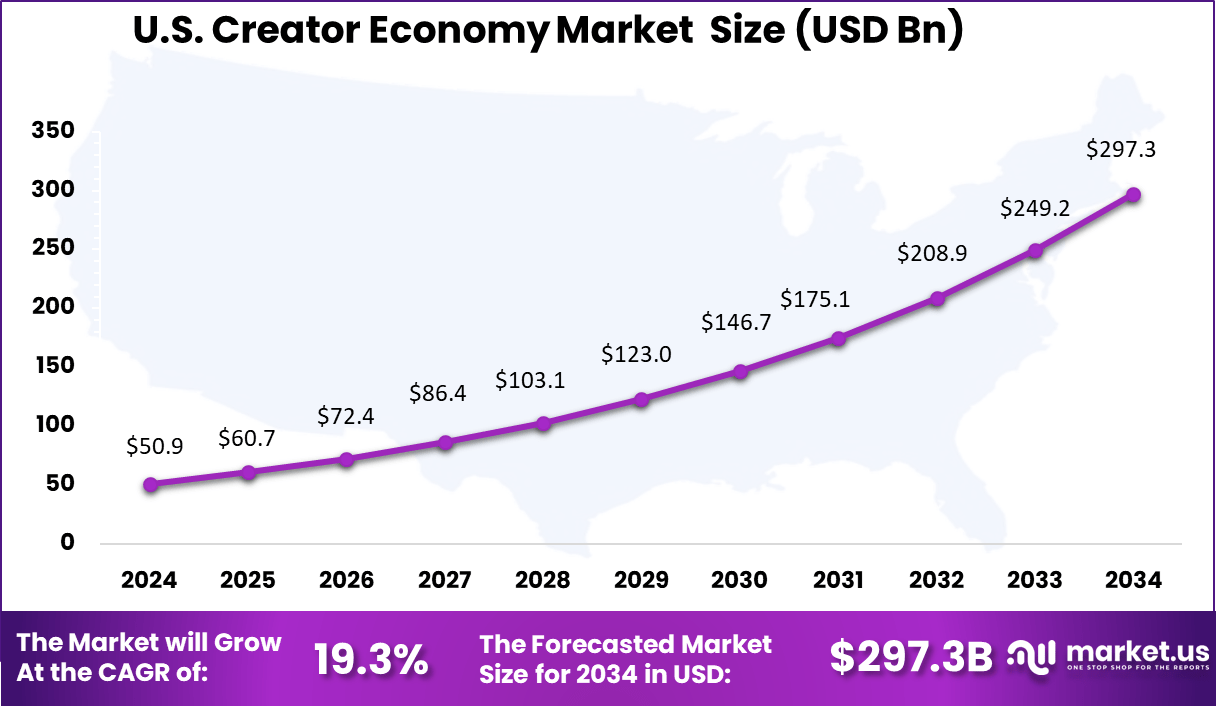
- North America is expected to reach USD 331.4 billion by 2034, growing at a CAGR of 19.5%.
- Europe’s Creator Economy market is projected to reach USD 112.42 billion by 2034, from USD 14.3 billion in 2024, with a CAGR of 22.9%.
- The APAC Creator Economy Market is expected to grow at a 25.1% CAGR, reaching USD 390.7 billion by 2034, from USD 41.6 billion in 2024, with China’s market valued at USD 16.7 billion.
Creator Economy Startups Statistics
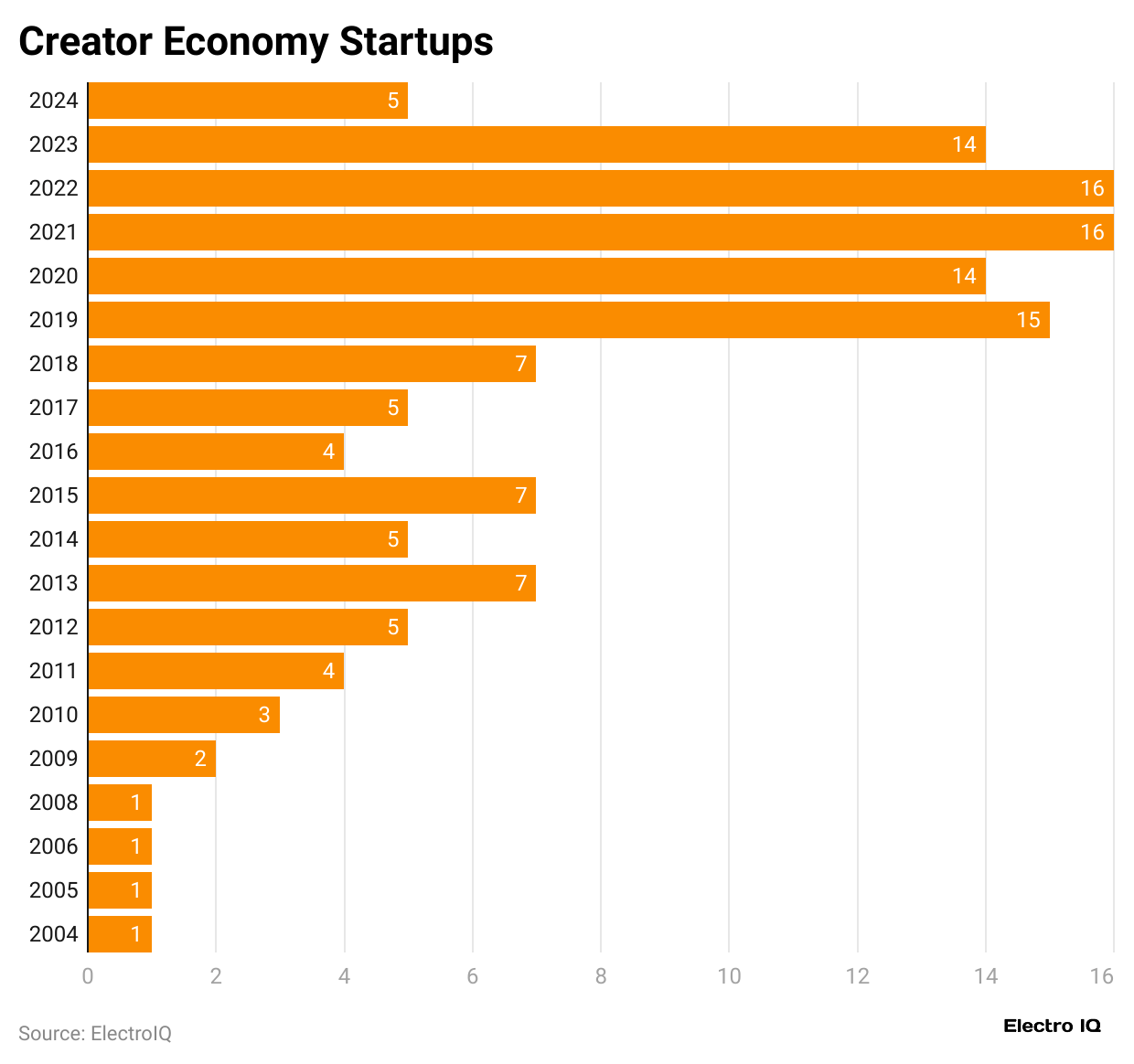
- In 2004, the creator economy saw steady growth with just one startup in 2004, 2005, 2006, and 2008.
- In contrast, rising to 2 in 2009, 3 in 2010, 4 in both 2011 and 2016, and 5 in 2012, 2014, and 2017.
- Stronger growth appeared 7 in 2013, 2015, and 2018.
- The boom years followed by 15 in 2019, 14 in 2020 and 2023, and a peak of 16 in both 2021 and 2022, before 5 in 2024.
- Based on location, the creator economy startup landscape is dominated by the United States with 94 startups, followed by the United Kingdom with 16.
- Israel contributes 5, while Canada and Australia each have 4.
- Smaller hubs include Singapore, the Netherlands, and India, with two startups each.
By Platform
- In 2024, the creator economy market showed a diverse distribution, in which social media platforms held the largest share, accounting for 29.0% of the market, as mentioned in the report published by market.us in June 2025.
- Meanwhile, video streaming platforms made up 23.9% of the market, while content-sharing platforms held 15.0%.
- Audio platforms, which include podcasting services, accounted for 12.6%, and gaming platforms were close behind at 12.5%.
- The last 7.0% came from other platforms such as e-commerce sites and specialised creator tools.
- According to market.biz, the global content creator population is estimated at 200 million.
- Over 30 million creators are active on Instagram, 13 million on YouTube, 3 million on Twitch, and more than 2 million across other platforms.
- Twitch averages 2.6 million concurrent viewers with about 93,000 concurrent streamers.
- Full-time creators typically use 3.4 platforms to connect with audiences.
- On TikTok, Khaby Lame leads with 149.7 million followers, followed by Charli D’Amelio at 147.1 million and Bella Poarch with 91.7 million.
- supplygem.com shows that Instagram leads the creator space with 92% adoption, followed by YouTube at 70%. Facebook (45%) and blogs (44%) remain relevant, while TikTok engages 35% and Twitter 33%.
- LinkedIn accounts for 19%, Pinterest 15%, and Twitch, the least used, sees only 6% of creators active.
By Content Types
- As of 2024, video content held the largest share of the creator economy, accounting for 24.4% of the market.
- Besides, music followed closely at 19.0%, while gaming also represented a significant portion at 17.2%.
- Audio-based content, including podcasts, made up 14.0%, and photography, digital art, and memes contributed 10.4%.
- Written content, such as blogs and newsletters, represented 8.7% of the share, and other categories, including educational material, accounted for 6.2%.
By Demographics
- According to supplygem.com, Millennials (born 1981–1996) make up 48% of all creators, making them the largest age group in the creator economy.
- Around 71% of creators are over 30, with the average age at 37.
- Within this, 36% are 40 or older, 22% fall between 26–39, while 14% are 16–25 and growing. Seniors over 60 represent 6%.
- Gender split shows 55.7% male and 44.3% female creators.
About 77% of creators started monetizing within the past year. - 30% began monetizing to earn extra income, and 48% now make at least half their income from creative work.
By Monetization Methods
- According to market.us reports in 2024, brand collaborations made up the largest share of creator earnings at 22.7%.
- Advertising revenue was close behind at 22.1%, and subscriptions contributed a share of 20.0%.
- Affiliate marketing generated 12.5%, while merchandise sales accounted for 11.4% giving creators another steady stream of income.
- Donations and tips added 6.3%, and other smaller methods made up 4.9%.
By Content Creators
- A report published by Demand Sage shows that there are about 207 million content creators worldwide, with nearly 200 million active and over 2 million identified as experts.
- In the United States alone, the community includes more than 45 million professionals.
- Recreational influencers, who have between 0 and 1,000 followers, make up around 23 million creators.
- Semi-pro influencers with 1,000 to 10,000 followers form the largest group, numbering about 139 million.
- Pro influencers, reaching audiences of 10,000 to 100,000, account for 41 million.
- Expert influencers with 100,000 to 1 million followers stand at 2 million, while another 2 million fall into the Expert+ category with over 1 million followers.
By Region
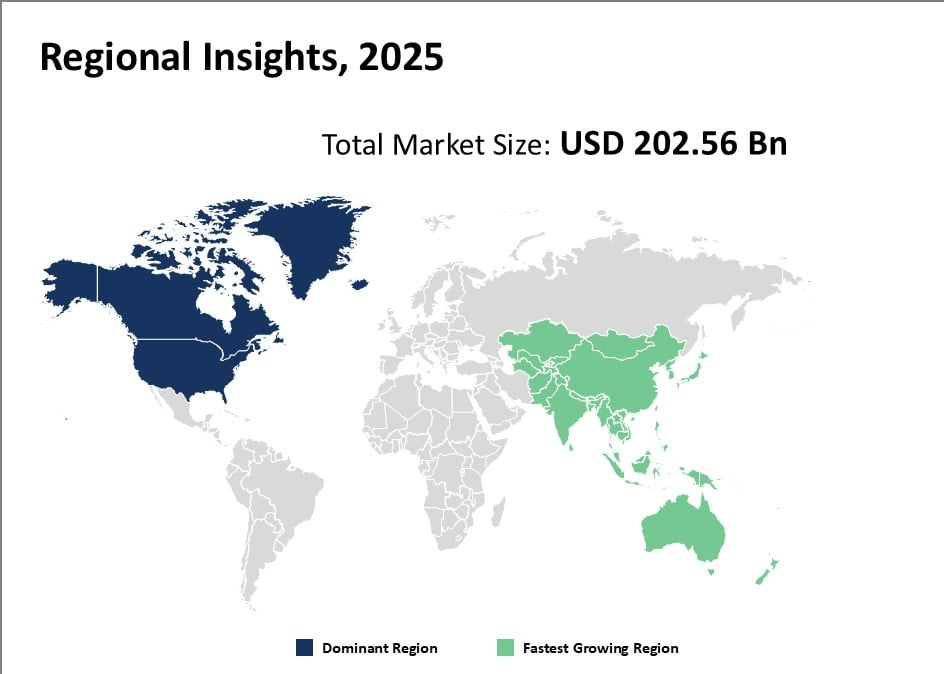
- In 2025, North America is projected to lead the creator economy with more than 35% of the market share, and Europe will follow with over 25%.
- Meanwhile, the Asia Pacific region will expand the fastest, expecting a growth rate of over 20% CAGR from 2025 to 2032.
Region-wise market valuation of the Creator Economy from 2025 to 2030 is stated in the table below:
| Year | North America | Asia & Oceania | Europe | South America |
| (USD billion) | ||||
|
2025 |
32.28 | 24.73 | 15.35 | 4.36 |
| 2026 | 43.48 | 28.72 | 18.7 |
5.55 |
|
2027 |
58.57 | 33.34 | 22.78 | 7.08 |
| 2028 | 78.89 | 38.71 | 27.74 |
9.03 |
|
2029 |
106.27 | 44.94 | 33.79 | 11.51 |
| 2030 | 142.91 | 52.17 | 41.17 |
14.67 |
Countries With the Most Creators Statistics
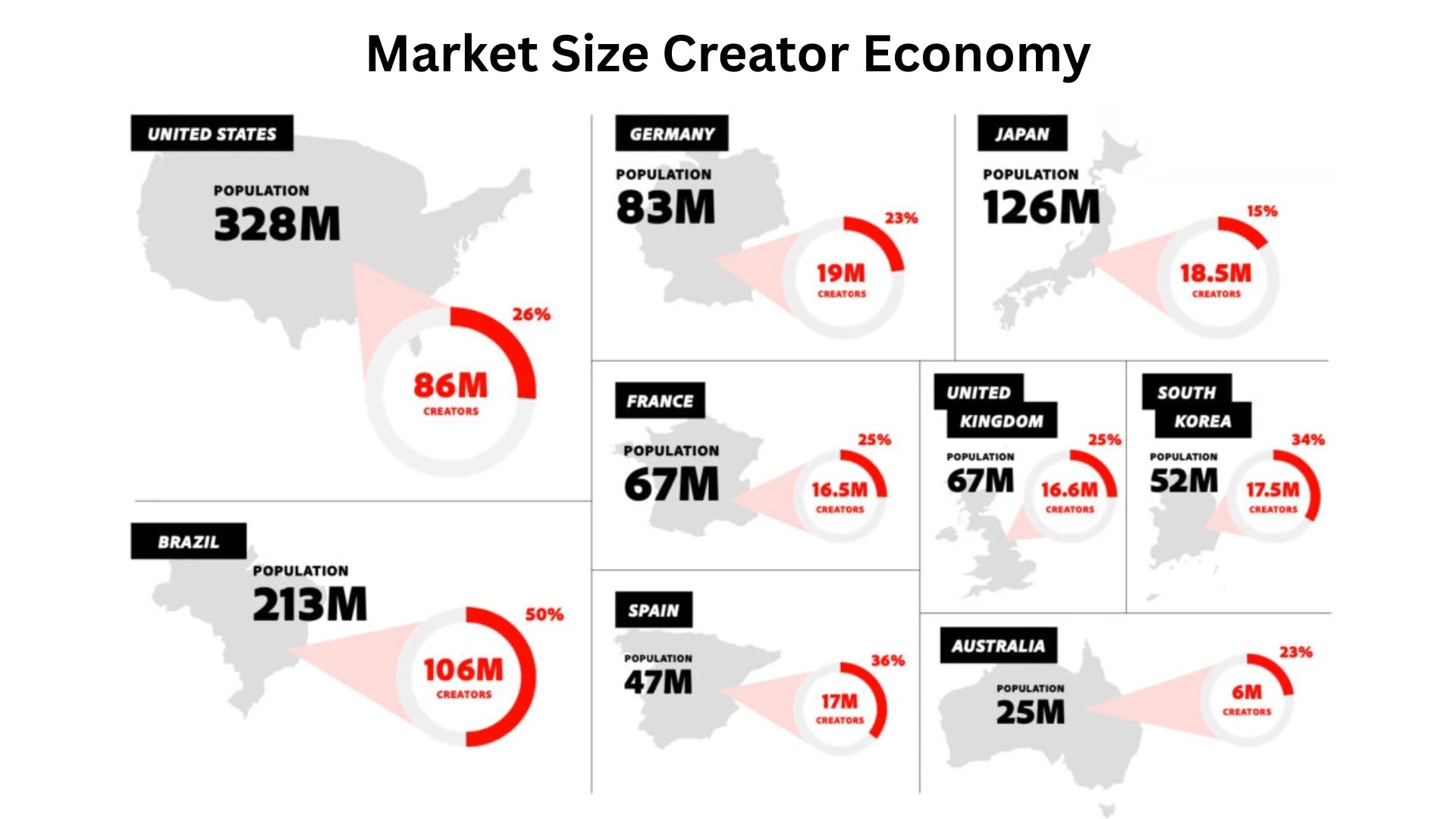
- Brazil accounted for the largest number of creators at 106 million and the highest share of its population at 50%.
- The United States comes next with 86 million creators, making up 26% of its people.
- Germany follows with 19 million creators (23%), while Japan has 18.5 million (15%).
- South Korea counts 17.5 million creators (34%), and Spain has 17 million (36%).
- The United Kingdom is home to 16.6 million creators (25%), France has 16.5 million (25%), and Australia records 6 million creators, which is 23% of its population.
Content Creator Top Revenue Sources Statistics
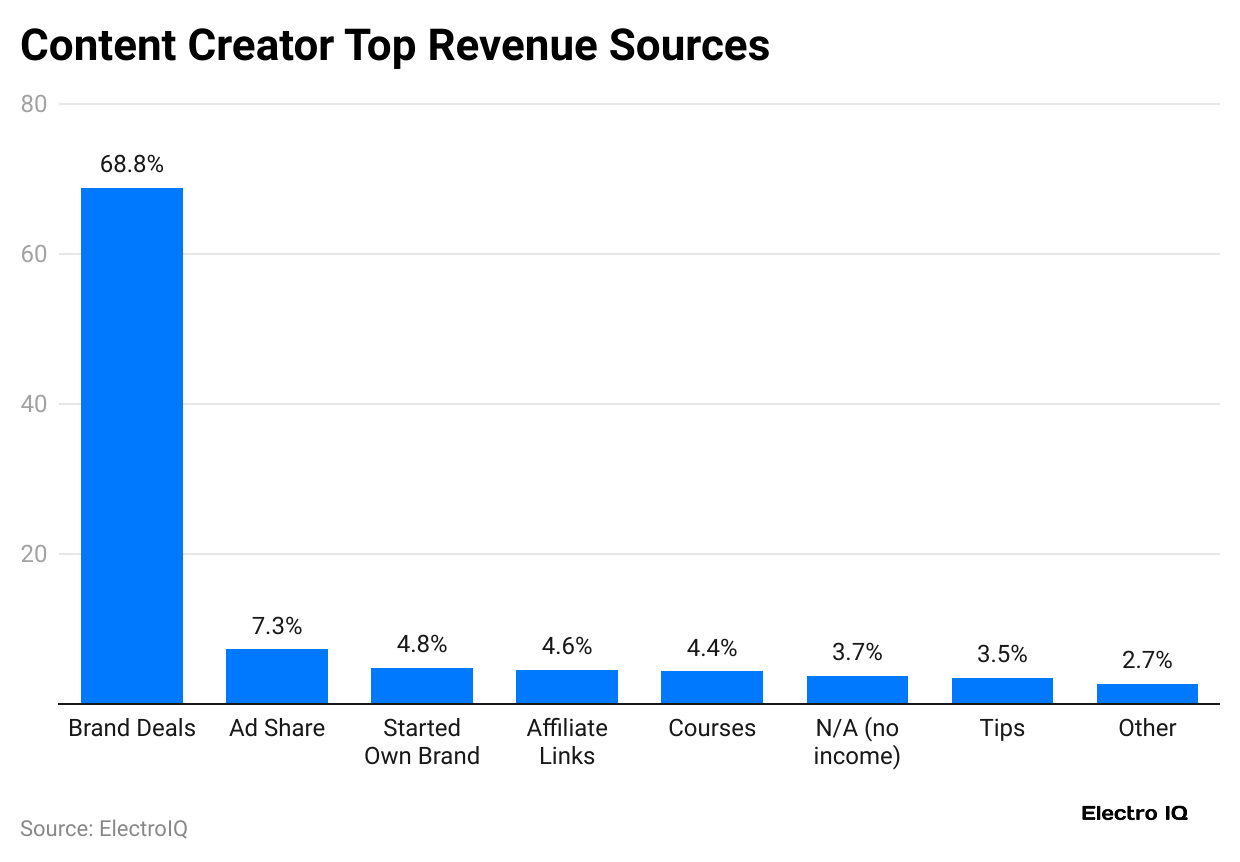
- The above graphical analysis stated that in 2024, most creators earned their income mainly through brand deals, which made up 68.8% of their revenue.
- The second-biggest source was ad revenue sharing at 7.3%.
- A smaller portion of creators focused on building their own brands, contributing 4.8%, while affiliate links were close behind at 4.6%.
- Online courses accounted for 4.4% of earnings, and 3.7% of creators reported making no income at all.
- Tips from followers added 3.5%, and other income sources made up the remaining 2.7%.
Company Supporting Creator Economy by Revenue
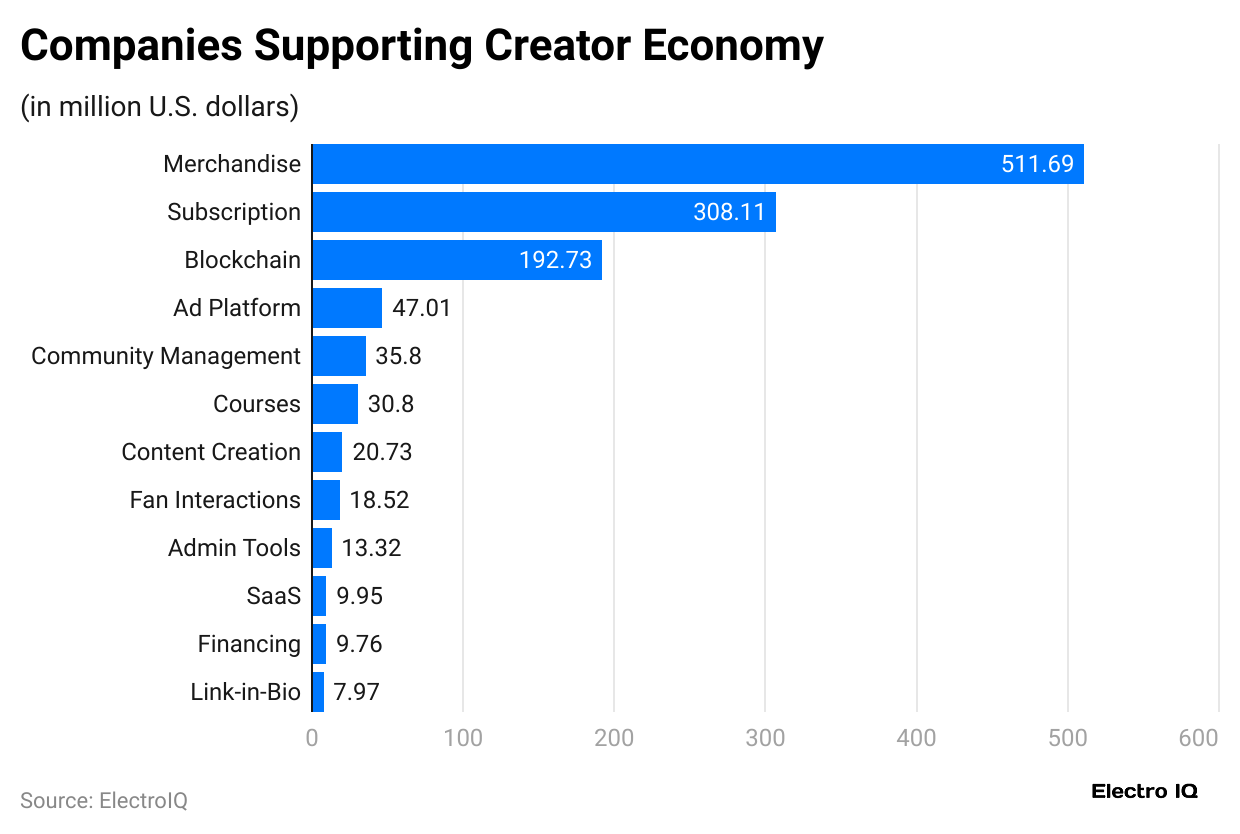
- In 2024, merchandise companies made the most money in the creator economy, with average earnings of USD 511.69 million.
- Coming next were subscription-based businesses, bringing in about USD 308.11 million.
- Blockchain-related companies bring in close to USD 192.73 million, while advertising platforms see about USD 47.01 million.
- Furthermore, other types of companies supporting the creator economy with their average annual revenue are stated as community management/analytics and operations (USD 35.8 million), courses (USD 30.8 million), content creation (USD 20.73 million), fan interactions (USD 18.52 million), and admin tools/analytics and operations (USD 13.32 million), SaaS (USD 9.95 million), financing (USD 9.76 million), and link-in-bio (USD 7.97 million).
Ways Brands Can Leverage the Booming Creator Economy
- The first step is finding creators, with mega-influencers offering vast visibility through millions of followers but demanding high costs.
- According to a report by Aspire, macro-influencers who have between 200,000 and 1,000,000 followers are often full-time professionals.
- Mid-tier influencers, with follower counts ranging from 60,000 to 200,000.
- Micro-influencers have 10,000 to 60,000 followers, while nano-influencers have 1,000 to 20,000 followers.
Creator’s Earning Statistics
- In 2025, Business Insider reports that global creator earnings, paid directly to creators, are expected to reach USD 185 billion, showing a 20% increase from 2024.
- Forbes highlights that the combined income of the top 50 richest creators stands at USD 853 million.
- Data from Influencer Marketing Hub reveals that more than half of all creators make under USD 15,000 a year.
- At the same time, 57% of full-time creators earn below the U.S. living wage of about USD 44,000.
- Zencast notes that 96% of creators earn less than USD 100,000 annually.
- In contrast, Blogging Wizard points out that only 12% of full-time creators make over USD 50,000 each year.
Creator Economy Engagement Statistics
- The average engagement rate of micro-influencers is about 3.86%, while mega-influencers manage only around 1.21%, as noted by Meltwater and Stack Influence.
- In the U.S., TikTok clearly leads the way with an average engagement of 18%, far ahead of YouTube at 0.51% and Instagram at 2.39%, according to Sociallyin.
- YouTube creators with audiences between 100K and 1M subscribers achieve an average engagement rate of 4.14%, as reported by Blogging Wizard.
- On Instagram, the platform’s overall engagement is lower at 0.70%, but smaller creators can reach up to 6.9%, according to Amra and Elma LLC and Views4You.
- Other platforms also show different levels: LinkedIn records 6.50%, Facebook 5.07%, Pinterest 4.7%, TikTok 4.86%, and Twitter (X) only 2.31%, based on GlobeNewswire.
- Content format makes a difference in Instagram’s average a 10.5% view rate with 4.36% engagement, compared to weaker Story results, according to Reddit.
- At Cannes 2025, Instagram influencer content delivered USD 203 million in earned media value, more than twice 2024’s USD 86.3 million, as Vogue Business highlights.
Conclusion
The creator economy has become a major global industry, where millions of people now earn money by using their creativity. Platforms such as Instagram, YouTube, and TikTok play a big part in helping creators share content, set trends, and build careers.
Engagement, income opportunities, and the mix of age groups show how quickly this space is changing. Millennials make up the largest group of creators, but younger generations are joining fast. With new technology shaping the way forward, the creator economy will only grow stronger in the coming years.
Sources
FAQ.
Platforms include YouTube, TikTok, Instagram, Twitch, Patreon, Substack, OnlyFans, and Ko-fi.
Creators need storytelling, content creation, social media, marketing, community building, analytics, and monetisation skills.
Through ads, sponsorships, subscriptions, merchandise sales, fan donations, and affiliate marketing.
Video, livestreams, courses, podcasts, newsletters, and digital products are currently the most profitable content types.
Challenges like platform dependency, income instability, high competition, audience retention, copyright issues, and managing taxes and contracts.
Yes, anyone with creativity, skills, or knowledge can join the Creator Economy by producing content and engaging audiences.

Maitrayee Dey has a background in Electrical Engineering and has worked in various technical roles before transitioning to writing. Specializing in technology and Artificial Intelligence, she has served as an Academic Research Analyst and Freelance Writer, particularly focusing on education and healthcare in Australia. Maitrayee's lifelong passions for writing and painting led her to pursue a full-time writing career. She is also the creator of a cooking YouTube channel, where she shares her culinary adventures. At Smartphone Thoughts, Maitrayee brings her expertise in technology to provide in-depth smartphone reviews and app-related statistics, making complex topics easy to understand for all readers.



